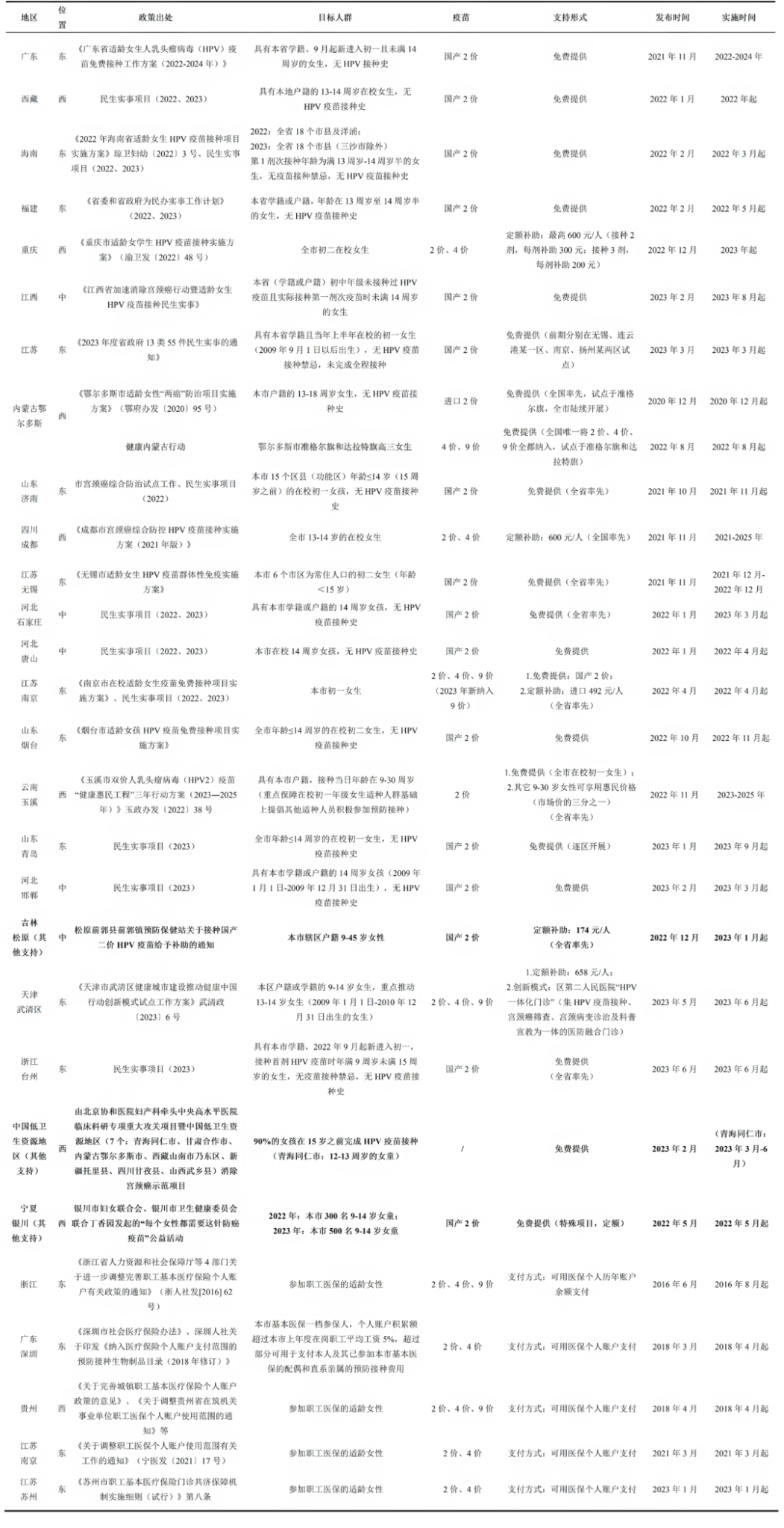Policy Update
01
Jungar Banner Implements Universal Vaccination Benefit Policy: Up to 60% Government Subsidy for Multiple Non-NIP Vaccines
Recently, Jungar Banner in Inner Mongolia launched a series of pro-public vaccination policies, providing government subsidies or free access to non–National Immunization Program (non-NIP) vaccines for different population groups across the banner. The policy covers all residents with Jungar Banner household registration, who are entitled to a 60% government subsidy for all non-NIP vaccines. Residents without local household registration are also eligible for varying levels of subsidies and preferential measures. In addition, free vaccination programs have been introduced for certain priority groups, including the bivalent HPV vaccine for women aged 9–45, influenza and pneumococcal vaccines for older adults, as well as hepatitis B and herpes zoster vaccines for adults.
Source: Jungar Banner Center for Disease Control and Prevention
Journal Article Recommendation
01
Influenza vaccination to improve outcomes for patients with acute heart failure (PANDA II): a multiregional, seasonal, hospital-based, cluster-randomised, controlled trial in China
This study, published in The Lancet by Du Xin, Craig Anderson, and colleagues, aimed to evaluate whether administering seasonal influenza vaccination to moderate-to-severe patients hospitalized with acute heart failure before discharge could reduce the risk of the composite endpoint of all-cause mortality and rehospitalization within 12 months. The trial was conducted across three consecutive influenza seasons (2021–2024) in 164 hospitals across 12 provinces in China, using a multi-regional, cluster-randomized controlled design. Eligible participants were adults aged 18 years or older with moderate-to-severe heart failure (NYHA class III–IV) and no contraindications to influenza vaccination, treated at hospitals equipped to provide bedside services.
Hospitals were randomized by cluster, stratified by province, and re-randomized annually (1:1) to either the intervention or usual care group. In the intervention group, patients received free influenza vaccination at hospital discharge (“in-hospital vaccination strategy”), whereas in the usual care (control) group, patients were advised to seek influenza vaccination at community facilities at their own expense. The primary endpoint was a composite of all-cause mortality or rehospitalization within 12 months after discharge, excluding events within 30 days and limiting northern site events to the winter season. Analyses were conducted using a modified intention-to-treat (mITT) approach with individual-level effects, employing a two-level logistic regression model that incorporated year fixed effects and hospital and hospital-period random effects.
A total of 7,771 participants were enrolled, with 3,570 in the vaccination group and 4,201 in the usual care group. Vaccination coverage was 94.4% in the intervention arm and 0.5% in the control arm. The incidence of the primary composite endpoint (all-cause death + all-cause rehospitalization) was 41.2% (1378/3342) in the vaccinated group compared to 47.0% (1843/3919) in the control group, corresponding to an odds ratio (OR) of 0.83 (95% CI 0.72–0.97; p=0.019). The 12-month all-cause mortality rate was 10.0% in the vaccinated group, significantly lower than 12.8% in the control group (OR 0.76, 95% CI 0.69–0.84; p<0.0001). Sensitivity analyses supported the main findings. Moreover, the incidence of serious adverse events was significantly lower in the vaccination group (52.5%, 1809/3444) compared with the control group (59.0%, 2426/4110; OR 0.82, 95% CI 0.70–0.96; p=0.013).
The study concluded that administering seasonal influenza vaccination prior to discharge for patients hospitalized with acute heart failure significantly reduced the risk of all-cause mortality or rehospitalization within 12 months, with a favorable safety profile. Integrating influenza vaccination into the in-hospital care pathway for heart failure patients represents a feasible and effective strategy, including for high-risk populations in resource-limited settings.
https://doi.org/10.1016/S0140-6736(25)01485-0
02
Post-Marketing Safety Surveillance of HPV Vaccines in Anhui Province, China, 2017–2024
This article, published in Vaccines by Wu Jiabing and colleagues, is based on surveillance data of suspected adverse events following immunization (AEFIs) with the human papillomavirus (HPV) vaccine in Anhui Province from 2017 to 2024. The study aimed to systematically evaluate the post-marketing safety of HPV vaccines to provide scientific evidence for the sustainable advancement of immunization programs and to strengthen public confidence in vaccination. Data were derived from the HPV vaccine AEFI reports recorded in the China National Immunization Information System (CNIIS), with vaccine dose data obtained from the Anhui provincial immunization information management system.
During the surveillance period, a total of 7,038,333 doses of HPV vaccines were administered in Anhui Province, with 1,149 AEFI cases reported, corresponding to an overall reporting rate of 16.32 per 100,000 doses. The reporting rates for common adverse reactions, rare adverse reactions, psychogenic reactions, and coincidental events were 15.15, 0.85, 0.17, and 0.14 per 100,000 doses, respectively. No events were reported to be directly related to vaccine quality defects or administration errors. Among common adverse reactions, the incidence rates of local swelling at the injection site (diameter >5.0 cm), induration (diameter >5.0 cm), and fever (axillary temperature ≥38.6 °C) were 0.60, 0.33, and 1.34 per 100,000 doses, respectively. Rare adverse reactions were mainly allergic responses, including allergic rash (0.50 per 100,000 doses), urticaria (0.09 per 100,000 doses), and sterile abscess (0.03 per 100,000 doses). Severe allergic reactions such as anaphylactic shock were extremely rare (0.03 per 100,000 doses). Neurological events, such as Guillain–Barré syndrome, were reported at very low rates, and no causal relationship with the vaccine was established. Furthermore, the majority of AEFIs occurred within 24 hours after vaccination (87.03%) and were more common following the first dose (50.39%). Severe AEFIs accounted for only 1.31% of cases, and most resolved spontaneously or after symptomatic treatment.
In conclusion, from 2017 to 2024, the reporting rate of AEFIs following HPV vaccination in Anhui Province remained low, with severe adverse reactions being rare. The study demonstrates that HPV vaccines have favorable safety and tolerability profiles, supporting their use as a key intervention in cervical cancer prevention.
https://doi.org/10.3390/vaccines13080846
03
Bridging the gap in pneumonia prevention: Qualitative insights on vaccine implementation from health leaders in middle-income countries
This article, published in PLOS Global Public Health, aimed to explore the challenges and opportunities faced by middle-income countries (MICs) in introducing pneumococcal conjugate vaccines (PCVs). Using a qualitative research design, the study conducted purposive sampling and carried out semi-structured interviews in 2023 with 17 stakeholders from Egypt, Jordan, Sri Lanka, and Thailand, including national immunization program officials, academic researchers, and representatives from international health organizations. The inquiry focused on three key dimensions: policy environment, implementation capacity, and global collaboration.
The study identified six major themes, with two factors serving as important drivers of successful PCV introduction: the presence of robust primary health care systems and well-established vaccine decision-making processes. At the same time, three key barriers to implementation were highlighted: (1) lack of information on disease burden and vaccine products; (2) competing domestic health priorities; and (3) insufficient sustainable financing mechanisms. The interplay of these factors underscored a unique “vaccine introduction paradox” in MICs: despite having relatively high immunization coverage and strong commitments to health equity, systemic challenges hinder the adoption of new vaccines, further exacerbating inequalities in vaccine access. Although some MICs have recently become eligible for support from Gavi, the Vaccine Alliance, the persistent absence of a tiered pricing mechanism tailored to MICs’ long-term affordability limits their ability to address actual demand, particularly given the global context where low-income and displaced populations are concentrated. The study also noted that barriers to PCV introduction could be mitigated through support from global and regional actors, including strengthening technical capacity, advancing policy advocacy, and providing strategic financial assistance.
The findings emphasize that as global efforts toward vaccine equity continue, accelerating PCV adoption in MICs requires not only domestic policy optimization and system strengthening but also joint global and regional collaboration in innovative financing, capacity building, and advocacy. Such combined efforts are essential to bridging immunization gaps and safeguarding population health.
https://doi.org/10.1371/journal.pgph.0004473
04
Emergency Department Survey of Vaccination Knowledge, Vaccination Coverage, and Willingness to Receive Vaccines in an Emergency Department Among Underserved Populations —Eight U.S. Cities, April–December, 2024
This article, published in Morbidity and Mortality Weekly Report (MMWR), aimed to assess the feasibility of using emergency departments (EDs) as novel settings for vaccination interventions targeting medically underserved populations. Between April and December 2024, a cross-sectional survey was conducted across 10 EDs in eight cities across five U.S. states, focusing on non-critical adult patients’ vaccine knowledge, vaccination status, and willingness to be vaccinated. Using a multistage stratified sampling design, 4,326 eligible patients were approached, and 3,285 (75.9%) consented and completed the survey.
The findings showed that nearly 30% of respondents identified as Black, about 27% as non-Hispanic White, and 31% as Hispanic; 18% primarily spoke Spanish, 7.8% experienced housing instability, and 21% lack of primary care. Approximately half (49.4%) of respondents had never heard of at least one CDC-recommended vaccine, and 85.9% were not up to date with recommended vaccinations. Factors associated with being under-vaccinated included non-Hispanic Black race/ethnicity (aOR = 1.93; 95% CI: 1.32–2.85), lack of access to primary care (aOR = 2.91; 95% CI: 1.74–5.13), and absence of health insurance (aOR = 3.01; 95% CI: 1.27–8.82). Among the 2,821 under-vaccinated respondents, 46.4% expressed willingness to receive at least one vaccine in the ED, and 86.7% of these indicated willingness to receive all missing vaccines. Age-specific patterns were noted: influenza vaccine gaps were highest among adults aged 18–49, shingles vaccine gaps were most common among adults aged 50–64, and RSV vaccine gaps were greatest among adults aged 65 and older. The primary reasons cited for missed vaccinations were “not knowing about the vaccine” or “not being offered the vaccine.”
The study concluded that EDs, as critical access points for underserved populations, hold potential as supplementary sites for vaccination services. Future strategies could include vaccine screening, recommendation, counseling, and referral services within ED settings to improve vaccination coverage and promote equity in immunization.
https://doi.org/10.15585/mmwr.mm7429a1
Content Editor: Tianyi Deng
Page Editor: Ruitong Li





